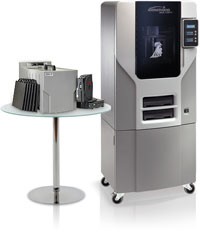Dimension 3D printers are a good rapid prototyping solution offered by the Stratasys company. There are two models of printers currently available – Dimension 1200es and Dimension Elite. Both of those models are aimed at small companies and engineering firms that require something bigger than a RepRap, but don’t need a 3D printing powerhouse producing super-dense hyper-durable and incredibly precise steel parts.
Both Dimension 3D printers print in plastic and offer accuracy, build volume, and speed suitable for the creation of mockups, models used for functional testing, or even fully-functional items.
How do Dimension 3D Printers Work?
Dimension 3D printers utilize a core process known as FDM, or fused deposition modeling. In this process (here’s a video of it) a string of plastic is let through a heated nozzle. Once the molten plastic hits the build platform, it hardens, and then another layer of plastic is added on top until the model is complete. Dimension 3D printers utilize ABS plastic which has decent material properties, allowing for creation of relatively precise models. ABS plastic’s material properties even allow for production of consumer or medical goods. However, the process is comparatively slow – though that can be remedied at the cost of accuracy.
| Dimension 3D Printer Specifications and Information | |
|---|---|
| Technology | FDM (Fused Deposition Modeling)Extrusion) |
| Frame Size (Width x Depth x Height) | ~ 33" x 29" x 45"/ ~ 83.8 x 73.7 x 114.3 cm |
| Weight | ~ 326 lbs / ~ 145 kg |
| Build materials | ABSplus plastic |
| Accuracy | Z axis: 0.254 or 0.33 mm |
| Build volume (X,Y,Z) | 10" x 10" x 12"/ ~ up to 254 x 254 x 305 mm |
| Price | Starting at $24.900 at the Dimension store |
| Price of material | $260 per 8lbs at the Amtek online store |
| Manufacturer’s website and contacts | http://www.dimensionprinting.com, phone number: +1 952.937.3000, address: Dimension, Inc., 7665 Commerce Way, Eden Prairie, MN 55344-2020 U.S.A. |
| Guides and books | User's Guide to Rapid Prototyping |
| Manufacturer’s forums and resources | Press releases, articles |
Pros:
Dimension offers solid 3D printers suitable for a lot of options. The material properties of ABSplus are very good – as good as traditional ABS plastic – making it possible to use Dimension 3D printer for manufacturing small batches of finished goods with complex geometry, production of models for field-testing or simply creation of concept models. The build volume is very good, too, and if you want to rapidly create a mode of a larger size, it’s very easy to connect printed parts together. The only real post processing required is removal of support material (by the way, the software shipped with the printer generates support automatically) – a very easy process. However, you can also sand and even electro-plate the finished part, if you so desire – or simply color it. However, Dimension 3D printers are able to print in different colors – and that’s a solid plus, too.
If you’re in the market for higher end 3D printers like the Dimension series for small-scale rapid prototyping, you may be interested in reading Rapid Prototyping and Engineering Applications.
Cons:
The speed may take “rapid” out of the “rapid prototyping.” Actually, it’s nowhere near that bad, but certain printers of the same price will offer you a higher speed. Speaking of price – it may seem a bit steep, too.
The Bottom Line:
Dimension 3D printers are a very solid choice for your rapid prototyping and manufacturing needs. While there are cheaper and faster printers available, the real pluses of Dimension 3D printers – which are great material properties as well as user-friendliness – will always shine through.

